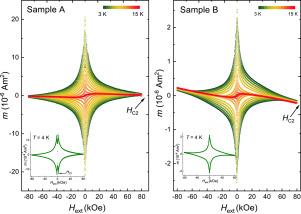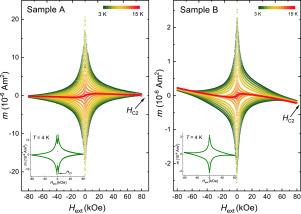高温下V3Si相形成及其超导性的原位研究
IF 6.9
2区 材料科学
Q2 CHEMISTRY, PHYSICAL
引用次数: 0
摘要
硅化钒(V33Si)是一种很有前途的与硅基电子器件集成的超导体,但是界面生长动力学对所产生的超导性能有很大的影响,并且尚未完全了解。在这项研究中,我们使用中子反射法来揭示在不同退火策略驱动下薄膜生长过程中的相变。在650-800°C的温度下,当一层薄薄的钒与硅上的二氧化硅膜发生反应扩散时,我们研究了硅化物的形成。为了进一步研究不同退火温度下不同相的时间演化,建立了化学模型并进行了后续的模拟。通过x射线衍射和透射电镜分析验证了该模型的正确性。观察到结构与超导性能之间的相关性。过度退火薄膜导致SiO2阻挡层完全耗尽,形成弥漫性界面,驱动不良富硅硅化物的形成。通过控制时间和温度来避免这种情况,可以获得更高质量的超导薄膜。发现薄膜的TcTc为13k,退火条件影响了TcTc附近的临界场和顺磁迈斯纳效应。对于最佳退火薄膜,计算了超导序参量。本文章由计算机程序翻译,如有差异,请以英文原文为准。


In-situ investigation of V3Si phase formation at high temperature and resulting superconductivity
Vanadium silicide (VSi) is a promising superconductor for integration with silicon-based electronics, however the interfacial growth kinetics have a strong influence on the resulting superconducting properties and are not yet fully understood. In this study, we have used neutron reflectometry to reveal the phase transformation during thin film growth driven by different annealing strategies. We examined the silicide formation when a thin layer of vanadium undergoes reactive diffusion with a silicon dioxide film on silicon at temperatures from 650–800 °C. To further investigate the time evolution of different phases under various annealing temperatures, a chemical model was developed and subsequent simulations were performed. The results of this model were validated using X-ray diffraction and cross-sectional TEM analysis. Correlations were observed between the structure and superconducting properties. Over-annealing films leads to complete depletion of the SiO2 barrier layer, forming diffuse interfaces and driving the formation of undesirable silicon-rich silicides. Avoiding this by controlling time and temperature, allows higher quality superconducting films to be achieved. The of the films was found to be 13 K, and the annealing conditions influenced the critical fields and the paramagnetic Meissner effect near . For optimally-annealed films, superconducting order parameters were calculated.
求助全文
通过发布文献求助,成功后即可免费获取论文全文。
去求助
来源期刊

Applied Surface Science
工程技术-材料科学:膜
CiteScore
12.50
自引率
7.50%
发文量
3393
审稿时长
67 days
期刊介绍:
Applied Surface Science covers topics contributing to a better understanding of surfaces, interfaces, nanostructures and their applications. The journal is concerned with scientific research on the atomic and molecular level of material properties determined with specific surface analytical techniques and/or computational methods, as well as the processing of such structures.
 求助内容:
求助内容: 应助结果提醒方式:
应助结果提醒方式:


